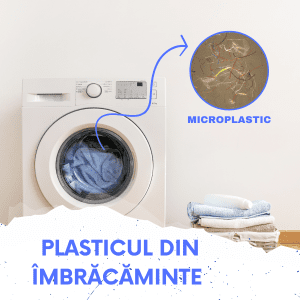Did you know that nearly 70% of all clothing on the planet is made of plastic? The development of new textiles such as polyester and nylon has facilitated the emergence of so-called "fast fashion", where clothing items are worn on average only 7 times, losing their appearance and durability very quickly. These poorly made clothes made of plastic materials have many harmful side effects, such as, for example, plastic pollution and poisoning our body. How does this happen? Simple. During production, wear and disposal, the plastics that are used in clothing release small fragments called microfibers. These particles are less than 5 millimeters in size and belong to the family of microplastics, which due to their small size end up in the air, water, and even the human body. So, are our clothes making us sick? Scientific evidence demonstrates that plastic emissions from our clothes are a cause for serious concern. It is virtually impossible to avoid exposure to microplastic fibers in our daily lives and removing these polluting microfibres from the environment is quite complicated. It is therefore imperative that mitigation measures are taken to reduce the release of plastic microfibers at source.
 More than two-thirds of the fabrics used to make clothing worldwide comprise plastics such as polyester, acrylic and nylon. To better understand this: in 2020 the world needed exactly 59.7 million tons of fossil-based virgin fibers to cover the needs of the textile industry. Of all the materials used worldwide for clothing, polyester is the most used. 57 million tons of polyester were produced, accounting for 52% of the global fiber market in 2020, and polyamide (nylon) had a market share of 5%. By 2030, global fiber demand is expected to be 135 million tonnes annually, with over 75% representing synthetic materials. If in the year 2000 50 billion new articles of clothing were manufactured, almost 20 years later this figure has doubled, according to the Ellen MacArthur Foundation. Every year, 100 billion new pieces of clothing are produced globally, which is almost 14 items for every person on the planet. The average consumer buys 60% more clothes each year, but wears them 50% less time compared to 15 years ago.
More than two-thirds of the fabrics used to make clothing worldwide comprise plastics such as polyester, acrylic and nylon. To better understand this: in 2020 the world needed exactly 59.7 million tons of fossil-based virgin fibers to cover the needs of the textile industry. Of all the materials used worldwide for clothing, polyester is the most used. 57 million tons of polyester were produced, accounting for 52% of the global fiber market in 2020, and polyamide (nylon) had a market share of 5%. By 2030, global fiber demand is expected to be 135 million tonnes annually, with over 75% representing synthetic materials. If in the year 2000 50 billion new articles of clothing were manufactured, almost 20 years later this figure has doubled, according to the Ellen MacArthur Foundation. Every year, 100 billion new pieces of clothing are produced globally, which is almost 14 items for every person on the planet. The average consumer buys 60% more clothes each year, but wears them 50% less time compared to 15 years ago.
9 million tons of plastic end up in the ocean every year. When released into the environment, the plastic material is fragmented into particles smaller than 5 mm (microplastics) or into fragments even smaller than < 0.1 μm (nanoplastics). The vast majority of microplastics come from the breakdown of larger plastic waste, for example through exposure to UV light, physical abrasion of household waste, laundry, agricultural film, construction work or fishing nets. What started as a marine pollution problem has also become a human health problem. Since the beginning of the 21st century, the scientific evidence that micro and nanoplastics pose a health risk to all life on earth has grown enormously. In the world's major cities, such as Paris and London, the outdoor air contains large amounts of plastic fibers – 17%.
In 2019, scientific results on the potentially harmful effects of micro and nanoplastics on our health were presented at the Plastic Health Summit in Amsterdam. The body of scientific evidence has grown enormously in recent years and we now know much more about the harmful effects of microplastics on our lungs. Dislodged synthetic fibers from clothing are a major cause of acute or chronic inflammation. Outdoor and indoor dust contains microplastic fibers and especially enclosed spaces contain high concentrations (about 30%). In most societies, people spend about 90% of their time indoors, where they are exposed to these particles. Once inhaled, microfibers can penetrate lung tissue and cause chronic inflammation, which is known to be a leading cause of diseases such as cancer, heart disease, asthma and diabetes. Inhaled microplastics can reach the liver, heart, kidneys and brain and even the fetus. Through ingestion of food and beverages, microplastics enter the gastrointestinal tract and cause intestinal inflammation, oxidative stress, increased permeability, disruption of intestinal flora and other hazards to intestinal health. There is a clear relationship between high exposure to microplastic fibers (nylon) and two bowel diseases (Crohn's disease and ulcerative colitis). The level of toxicity and the effects of microplastic fibers on humans depend on the dose (expressed as either particle number or mass-weight), length and diameter, deposition rate, fiber durability and body immunity. Young children (< 0.5 years) inhale twice as much synthetic fibers and ingest twelve times as much as adults because young children touch their mouths with their hands much more often than adults. By spending a lot of time crawling on the floor, children are at greater risk of exposure to microplastic fibers. In their early biological development, children are particularly vulnerable to adverse effects.
 On average, every year each person inhales approximately 121,000 microplastic particles, 52,000 are ingested, which adds up to an amount of approximately 163,000 microplastic particles found in the human body (source: United Nations Environment Program (UNEP). From pollution to solution – a global assessment of marine litter and plastic pollution. UNEP, NAIROBI, 2021). It is estimated that 30 000–465 000 microfibers per m2 (or 175–560 microfibers/g) are shed from textile garments in the first wash cycle. Thanks to the widespread use of microplastics, and especially synthetic fibers, people are exposed to these particles everywhere and it is now common knowledge that we eat, drink and breathe plastic every day. For example, honey, sugar, salt, beer, milk and bottled drinking water contain microplastics, as does seafood such as oysters, clams, and fish. Over a lifetime, due to exposure to microplastics through ingestion and inhalation, children and adults are estimated to consume an average of 700 particles/capita/day, data collected from biological samples from the gut, body tissues and faeces. Apart from inhaling fibers as fine dust from the air, people are also exposed to microplastic pollution from home/office air. The first study to analyze microfibre pollution in indoor spaces was carried out in two apartments and an office at a distance of 10 km from Paris. All samples contained microfibres, of which 33% were of petrochemical (synthetic) origin, i.e. plastic. A recent study found that 30% in dust trapped in air conditioning filters in bedrooms, offices and living rooms are microplastic fibers such as polyester, cellophane and cellophane.
On average, every year each person inhales approximately 121,000 microplastic particles, 52,000 are ingested, which adds up to an amount of approximately 163,000 microplastic particles found in the human body (source: United Nations Environment Program (UNEP). From pollution to solution – a global assessment of marine litter and plastic pollution. UNEP, NAIROBI, 2021). It is estimated that 30 000–465 000 microfibers per m2 (or 175–560 microfibers/g) are shed from textile garments in the first wash cycle. Thanks to the widespread use of microplastics, and especially synthetic fibers, people are exposed to these particles everywhere and it is now common knowledge that we eat, drink and breathe plastic every day. For example, honey, sugar, salt, beer, milk and bottled drinking water contain microplastics, as does seafood such as oysters, clams, and fish. Over a lifetime, due to exposure to microplastics through ingestion and inhalation, children and adults are estimated to consume an average of 700 particles/capita/day, data collected from biological samples from the gut, body tissues and faeces. Apart from inhaling fibers as fine dust from the air, people are also exposed to microplastic pollution from home/office air. The first study to analyze microfibre pollution in indoor spaces was carried out in two apartments and an office at a distance of 10 km from Paris. All samples contained microfibres, of which 33% were of petrochemical (synthetic) origin, i.e. plastic. A recent study found that 30% in dust trapped in air conditioning filters in bedrooms, offices and living rooms are microplastic fibers such as polyester, cellophane and cellophane.
In a 2011 study, scientists collected samples of shoreline sediments from 18 locations around the globe (in Australia, Japan, the Arabian Peninsula, Africa, Europe, and North and South America). The researchers also took samples from wastewater treatment plants and washing machines. Almost 85% of the synthetic fibers in the sediment samples consisted of plastics such as polyester, acrylic, and nylon. Microplastic fibers are extremely difficult to remove from wastewater. By analyzing samples of wastewater from household washing machines, the researchers were able to demonstrate that a single article of clothing can produce more than 1,900 fibers per wash. Further research studies confirmed that washing the clothes resulted in the release of a significant amount of fibers, which increases as we increase the water temperature, the amount of detergent and the revolutions per minute. Polyester and cotton knitted fabrics account for most of the global fiber production for natural and synthetic fibers. After washing these two different types of fabric, it was shown that cotton garments release more fibers than polyester ones. However, cotton is completely biodegradable, while polyester does not undergo significant changes over time. In other words, polyester accumulates in the aquatic environment and cotton does not.
An emerging concern of plastics in the environment is the potential of microplastics to carry and transmit pathogens from one area to another. Certain zoonotic protozoan parasites are able to attach to microplastics, including polyester microfibers, in seawater. Fish and shellfish that ingest the infested fibers can cause illness in humans who consume these marine products. Many chemicals are added to fibers and textiles as flame retardants, waterproofing (eg PFAS), UV blockers and dyes. Chemical additives such as phthalates and bisphenol A (known endocrine disruptors) can leach from particles inside the body and interfere with hormones.
It is inevitable that synthetic microfibers will persist in the environment for long periods of time. As the human population grows and people use more synthetic textiles, the contamination of habitats and animals with persistent synthetic microfibers will increase and this is a serious cause for concern. Most fabric flow calculations in the fashion industry are based on high market demand. However, this is heavily influenced by the unsustainable business of the industry. "Fast fashion" is an unsustainable and polluting business model caused by countless new fashion trends and poor quality clothes. Synthetic (plastic) yarns are an ideal material to create garments with a short lifespan. As a result, the amount of fiber loss and post-production and post-consumption waste is immense. This makes the fashion industry one of the most polluting sectors in the world. It's not nice to admit it, but for years our favorite brands have been ignoring or denying the fact that their clothes are continuously polluting the environment with plastic. From the earliest stages of the production process, until the sweater, jacket or hat is finally thrown away, garments emit pollutants in the form of plastic microfibers. The reality is that nothing changes, these companies talk all the time about sustainability and greener production methods in order to cover up other major problems of environmental pollution and human intoxication.
What can we as consumers do to reduce microplastic pollution?
The answer is simple – using the clothes we purchase for as long as possible. Likewise, we can choose clothes made from recycled materials, natural fibers and ask brands to take plastic pollution in the fashion industry seriously.

